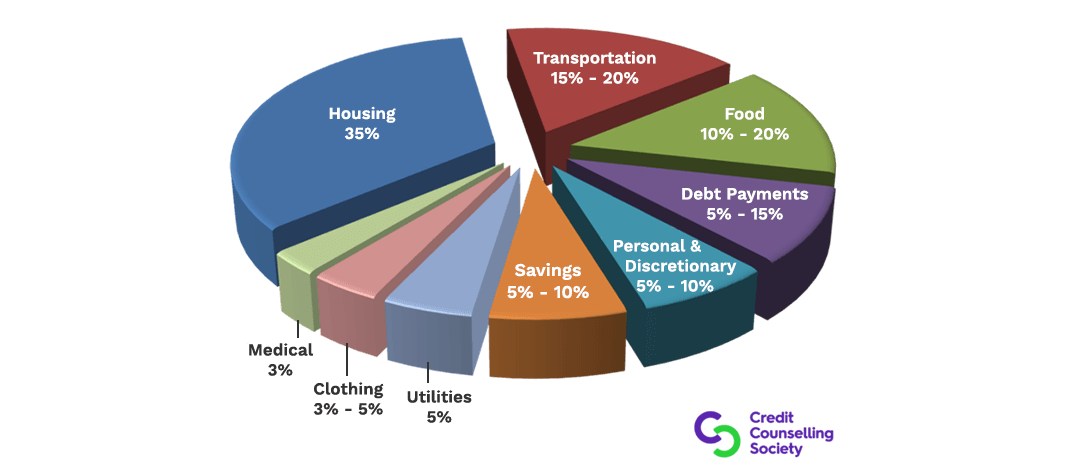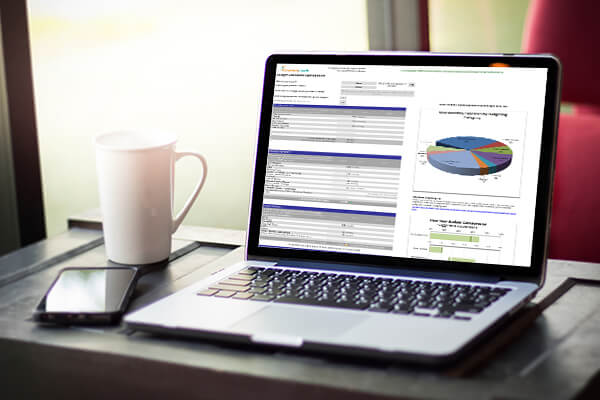Budget Breakdown for Monthly Costs
Time-tested, general budgeting guidelines for almost any level of income.
Living Expenses Guide: How Much Money Should You Spend?
Budgeting Guidelines for Income
Many people wonder how much of their income they should spend on their home, vehicle, groceries, clothes, etc. Below are some guidelines to give you a general idea and a starting point for your budget. What that will look like depends on your income, family circumstances, monthly expenses, and where you live.
Start working with these budgeting guidelines by developing your budget with your net income. You have left this money after government deductions from your paycheque but before voluntary deductions like RRSPs, pensions, or other savings. If you have expenses like high debt payments, childcare, school expenses, or giving, you’ll need to lower your spending in your budgeting process in other areas to allow for these higher expenses.
Budgeting Guidelines
Costs of Living by Category

Breakdown of Cost of Living Budget Categories
It’s important to write everything out when planning your financial goals, like paying off your debt against your monthly income and fixed expenses. This allows you to understand better where you are in your finances, as well as help to plan out how you’re going to get where you want to be.
Here is an example of how your budget percentages should look.
- Housing: 35% 35%
- Utilities: 5% 5%
Examples of utility costs are cell phone, gas, and internet bills. Nowadays, people also include their streaming services under utilities in lieu of what people used to pay commonly for cable services. Netflix, Hulu, and other streaming services can also be included as part of your utility bill.
- Food: 10-20% 20%
- Transportation: 15-20% 20%
- Clothing: 3-5% 5%
Shoes and clothes for all members of the family.
- Medical: 3% 3%
This includes premiums, specialists, and over-the-counter medication.
- Personal & Discretionary: 5-10% 10%
Money spent on entertainment, recreation, education, tobacco & alcohol, eating out, gaming, hair cuts, hobbies, and planned charitable giving are some examples. If you spend more in this category, make sure your budget balances by spending less elsewhere.
- Savings: 5-10% 10%
- Debt Payments: 5-15% 15%
By following this basic plan and opening separate accounts for different spending, as well as savings accounts, you can more easily plan out your budget percentages and work towards debt repayment.
How to View These Budgeting Guidelines to Get a Hold of Your Spending Habits
These guidelines have been created for someone who really needs to put together a tight budget. If finances aren’t strained in your household, you can choose to be more relaxed and go beyond the guidelines in areas as long as you’re careful to do two things:
- You’re not spending more than you earn, and
- You’re allocating some money towards savings (savings are absolutely necessary for life’s many unexpected expenses. Don’t rely on credit for these unexpected expenses. Rely on the money you’ve saved).
The category in these guidelines that people will most commonly exceed is the “Personal & Discretionary” expense category. The guidelines suggest you spend 5 – 10% of your income in this category. However, if you happen to have young children in daycare, have high education costs, take nice vacations, tithe, or have hobbies or recreational interests that aren’t cheap, you’ll quickly exceed the suggested maximum for this category. It’s important to know there is nothing wrong with exceeding this limit as long as your budget balances (your expenses don’t exceed your income).
You may also notice that if you spend the maximum amount in every category, you’ll exceed 100% of your income. These guidelines are only recommended ranges. Life is all about choices, but you can’t choose the maximum amount in all spending categories. Spending more in one category may mean that you’ll have to cut back in another category to make your budget balance. If you live in Canada’s far north or in a city where homes are very expensive, you may have to cut back more than an average Canadian would in the “Food” or “Housing” categories in order to afford your higher living costs.
The Easiest Way to Use the Guidelines
To make budgeting easier, we’ve built these budgeting guidelines into an Excel Budgeting Calculator Spreadsheet provided through our educational website, MyMoneyCoach.ca. It’s free and easy to use – even if you’ve never touched Excel before. If you don’t have Excel on your computer, you can also download it for the Mac or OpenOffice (free open source office software).
As you enter your living expenses, the interactive spreadsheet will calculate all the spending guideline numbers. It also visually compares your spending in each category to these guidelines to see how you’re doing. As you fill out the budget spreadsheet with your living expenses, it warns you if you’re going over the guidelines in any area of your budget and shows how your spending falls into these guidelines. It also suggests spending amounts for every budgeting category listed above based on your income and family size. It shows you what your budget looks like in a pie chart divided into the various expense categories when you’re done.
On top of all this, the budgeting calculator offers you tons of helpful suggestions and tips along the way so that you can avoid the common pitfalls of the budgeting process.
How to Create a Budget With Irregular or Fluctuating Income
If your income fluctuates, creating a budget with irregular income can be challenging. To make things easier, try using one of these three strategies for creating a personal budgeting plan for irregular income. These practical strategies will give you simple but effective ways to make sure you’re not spending too much in better months and have enough to spend in leaner months.
If you’d like to learn more about how to plan for and budget with irregular income and even ask questions along the way, you can in one of our free online workshops.
Last Updated on June 5, 2025
Need more help?
See how we can help you. Just answer 4 simple questions
If you can take a minute to answer these 4 multiple-choice questions, you can find out how we can help you. It will only take a minute, and what you discover may surprise you.
Need more help?
Ready to build better money habits and reduce your financial stress? Our Learning Hub offers free, self-paced online courses designed to help you master budgeting, credit, debt management, and more. Whether you're just getting started or looking to sharpen your financial skills, our easy-to-follow lessons and practical tools will guide you every step of the way. Start learning today and gain the confidence to make smarter financial decisions for a stronger tomorrow.
Learning Hub Reviews
Based on 72 reviews
Related Articles

Getting Rid of Debt
We’re happy to help you figure out your options. There are more than you might think.

Loan Calculator
Find out how much you can afford to borrow and repay, how long it will take, and what it will cost.
Track Your Spending
An essential part of building a budget is tracking how much you actually spend. Here’s how.
Was this page helpful?
Thanks for letting us know.





